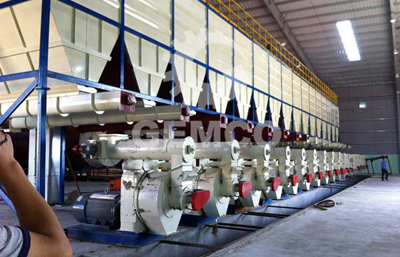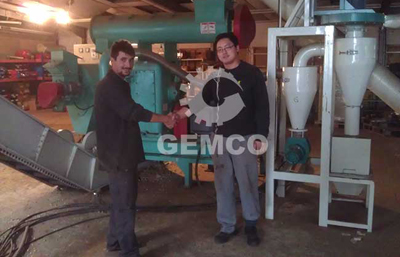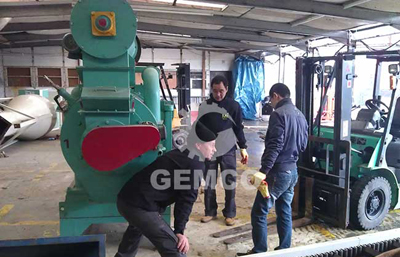What affects the biomass pellet quality in production?
In this article, we will analyze 3 factors that affect the quality of wood pellets: particle size of raw material, moisture content, compression ratio of the ring die. By experiments, we will work out the best producing parameters, so as to improve the wood pellet quality in production.
Biomass pellets are made of sawdust, crop straw, rice husks, peanut shell, and other agriculture and forest wastes. The pellet machine or briquette machine press them into solid bars or pellets, and used in boilers and stoves to replace coal and oil fuels. Owing to high energy density, low pollutant emission, wood pellets play a growing important role in industrial production and heating supply.
Experimental materials
For this experiment, we choose sawdust from coniferous trees, and uncrushed rice husks whose diameter is lower than 7mm. They have moderate water content and low impurity content. Dry them and mix them at the proportion of 70% rice husks and 30% sawdust.
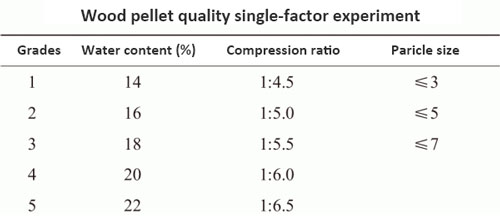
Pellet manufacturing equipment
We adopt horizontal type ring die pellet machine for this experiment. The roller is embedded in the ring die and keep still when the ring die start rotating. When we feed raw materials into the pellet machine, the roller press the raw materials out of the ring die, in which they are molded into pellets. Before making pellets, we need to pre-treat the raw materials by crushing, mixing, and drying.
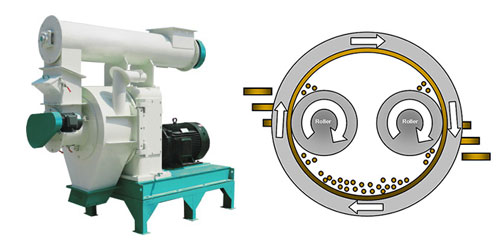
Experimental design and process
According to Preliminary experimental analysis, we figure out that the molding rate and density of wood pellets are determined by 3 factors: moisture content of raw materials, the compression ratio of ring die, and the particle size of raw materials. So, in this experiment, we set these 3 factors as variates, and analyze their impact on the wood pellet quality.
Set the baseline of 18% moisture content, 1:5.5 compression ratio, and under 7mm particle size. Select 5 degrees of moisture content, 5 degrees of compression ratio, and 3 degrees of particle size. For each degree, repeat the experiments for 3 times, and take the average. The following chart shows the parameters in every degree.
Experimental results and analysis
Raw material water content affect the wood pellet density and molding rate
Set the compression ratio of the ring die as 1:5.5, the particle size of raw materials as 7mm. Then test how the variation of moisture content affect the molding rate.
From the chart below, raw material water content has clear impact on the wood pellet density and molding rate. This impact have certain regularities.
- When the water content is 14%, the molding rate and the pellet density is the lowest.
- When the water content is 18%, the molding rate and the pellet density reach the top. After that, with the increase of water content, the molding rate and pellet density drop down.
- When the water content reach 22%, the molding rate is lower than 50% and the density is low.
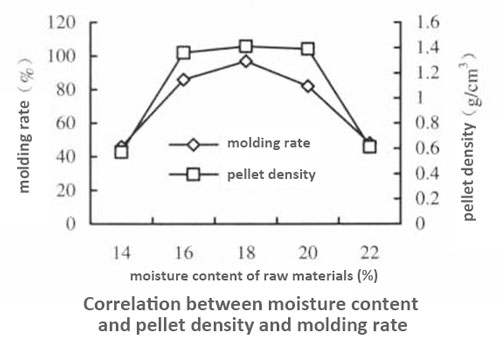
Compression ratio of the ring die affect the wood pellet density and molding rate
Set the water content of raw materials as 18%, the particle size as 7mm. Then test how the compression ratio of the ring die affect the molding rate and pellet density.
As the chart below shows, the compression ratio has obvious impact on the molding rate and pellet density. Their pattern is showed below.
- When the compression ratio is 1:4.5, the molding rate and pellet density is at the lowest level.
- When the compression ratio is 1:5.5, the molding rate reach the highest and the pellet density is near the top level.
- After the peak value, with the increase of the compression value, the molding rate drop down, while the pellet density has no obvious changes.
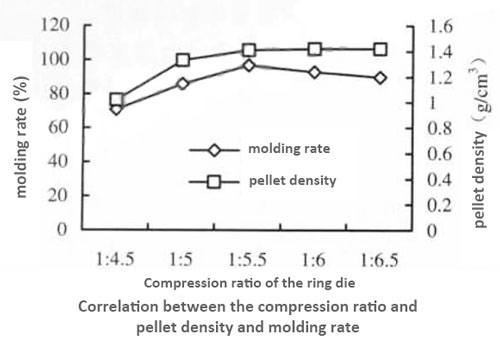
Raw material particle size affect the wood pellet density and molding rate
Set the water content of 18% and the compression ratio as 1:5.5, test how the variation of the particle size affect the molding rate and pellet density.
As the chart below shows, the particle size of the raw materials doesn’t have clear impact on the pellet density and molding rate. And there is no regularities or peaks.

Conclusion and advice
By combining the analysis above, we can find that the water content of raw materials and the compression ratio of the ring die has obvious impact on the molding rate and pellet density.
In terms of mixed sawdust and rice husk pellets, when the compression ratio is between 1:5 and 1:6.5, and the water content between 16%-20%, they have best quality, density and molding rate.
We receive enquiries in English, Español (Spanish), Русский язык (Russian), Français (French) and العربية (Arabic). Our professional team will reply to you within one business day. Please feel free to contact us!
